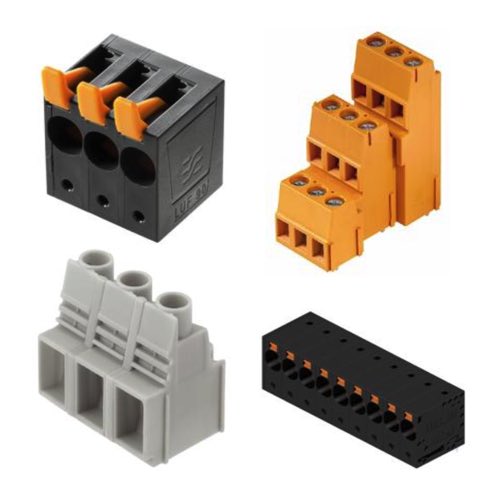PCB Terminal Connectors

PCB terminal connectors are essential components used to connect field wiring directly to printed circuit boards in power electronics and industrial systems. These connectors provide reliable wire-to-board connections that support consistent signal transmission and dependable power delivery. Their compact form factor and advanced connection technologies make them well suited for modern electronic designs where space efficiency and performance are critical.
Designed to support both low-voltage signal circuits and high-current power applications, PCB terminal connectors are available in a variety of configurations and connection methods. Many models are engineered to safely carry high current while maintaining secure mechanical and electrical contact, reducing the risk of overheating or connection failure. This makes them suitable for use in industrial controls, power supplies, automation equipment, and hybrid electronic assemblies. PCB terminal connectors offer installation and maintenance advantages by simplifying wiring and reducing assembly time. Their robust construction supports long-term reliability in demanding environments, while multiple connection technologies allow designers to select the best option for their application.
FAQs
Q: What are PCB terminal connectors used for?
PCB terminal connectors are used to connect wires directly to printed circuit boards for power and signal transmission in electronic and industrial systems.
Q: Can PCB terminal connectors handle high current applications?
Yes, many PCB terminal connectors are specifically designed to support high-current, low-voltage applications when properly sized and installed.
Q: Does a solder pin provide sufficient current capacity in industrial applications?
A properly designed solder pin can provide adequate current carrying capacity, depending on pin size, material, and PCB trace design.
Q: Are PCB terminal connectors suitable for space-constrained designs?
Yes, their compact design makes PCB terminal connectors ideal for wire-to-board connections in tight or densely populated electronic assemblies.
Q: Where are PCB terminal connectors commonly used?
They are commonly used in power electronics, industrial controls, automation equipment, and compact electronic devices requiring reliable wire-to-board connections.
Why Buy PCB Terminal Connectors from RSP Supply
RSP Supply offers a comprehensive selection of PCB terminal connectors designed for reliable power and signal connections in industrial electronics. Our product lineup supports compact designs, high-current applications, and dependable long-term performance across a wide range of control and power systems.

